An Almost Perfect Fit?
By Lynne and Larry E. Hall
The 2016 Honda Fit is well named. It isn’t too big, isn’t too small—it’s a good fit no matter what size the occupants are, and the yawning hatch can gobble up everything from large boxes to bikes to furniture.
Redesigned last year for the first time since model year 2009, the 2016 Honda Fit gets sleeker styling, additional features, more power and better fuel economy.
It’s refreshing to see the new Fit is aimed at not just being a good small car, but an exceptional car, period. It is bolted together as well as anything on the road, and feels more substantial than
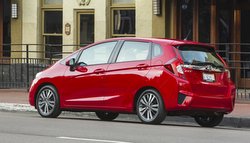
other cars in its price range.
A big bonus is fuel economy from the combination of a new 1.5-liter four-cylinder engine (the sole powerplant), and a continuously variable transmission (CVT). It earns an EPA estimated rating of 41-mpg highway/33-mpg city/36-mpg combined. There are few non-hybrid cars that achieve 40-plus mpg.
Priced on par with other popular small hatchbacks, four models are offered, beginning with the base LX. It sports a six-speed manual transmission and starts at $15,650, plus $820 destination charges. Enthusiasts may prefer a manual shifter, but will pay a fuel economy penalty—the LX with manual is rated at 37-mpg highway/29 city/32 combined.
Lynne Says….
Hatchbacks have been embraced by Europeans for years and shunned by Americans, which I don’t understand. If it had made economical sense, I would still be driving my 1979 VW Rabbit. But, when the odometer reached a little more than 200,000 miles, it had to go.
The hatchback body style is clearly the best way to maximize passenger and cargo room in small cars, and the 2016 Honda Fit is one of the more unusually proportioned examples. However, its styling serves a greater purpose than mere aesthetics.
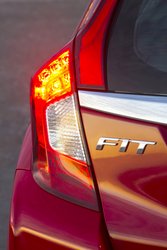
Fit has a stubby nose highlighted by slim, swept-back headlights. Its radically angled front roof pillars frame a huge windshield, and its long-roof, wagon-like body is chopped off just behind the rear wheels.
With lots of side-glass, small wheel openings, and an overall length of just 13 1⁄2 feet, the effect is a bit toy-like. But with the tall roofline and relatively generous wheelbase, Fit devotes most of its volume to cabin space.
Indeed, this subcompact surprises with room for four adults to ride in comfort and class-leading cargo versatility.
The outgoing Fit had a clean, simple front end and I was a little put off at first with the 2016’s new look—a large, solid grille design and aggressive, protruding lower air intakes. But, by the time we returned our test driver to Honda, I was won over.
However, I gave an immediate thumbs up to the stylist who erased the slab sides and penned strong, chiseled character lines, giving the new car an overall sleeker, more dynamic look. The backside is also more expressive with a full-width chrome bar that echoes the front grille and connects new LED taillights.
In total, the 2016 Honda Fit makes its own sort of fashion statement, and I like it.
Larry Says….
Lynne and I are still quibbling over the exterior styling changes to the 2016 Honda Fit; she likes the car a lot; I’m still on the fence. As for the interior, we’re in complete agreement.
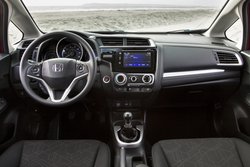
Honda took a modern approach in designing the 2016 Fit’s interior. Black is the only interior color, accented with silver trim. There’s a new center console with armrest (thank you), and tablet connectivity. Soft touch and textured plastic surfaces give an overall impression of refinement.
The instrument pod continues with a three-dial gauge setup with a large, centered speedometer. It also features Eco Assist lighting for the first time.
While the climate controls are large and easy to reach, there are no physical controls on the dash for the audio. Trying to tune the audio system or switch to the navigation system with the very small virtual buttons on the touchscreen means taking you eyes off the road.
Yes, there are steering wheel controls, but on a cold morning with gloves on, I found it nearly impossible.
Lynne and I came to the same conclusion; use an iPod for music and a smart phone for navigation.
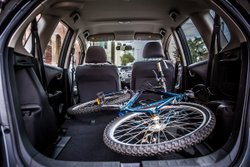
From the beginning, the Honda Fit was notable for its interior room, particularly for rear seat passengers. A big up tick for 2015, carried over for 2016, is there’s even more room.
It’s hard to spot, but the Fit’s wheelbase grows 1.2 inches, a gain that results in a remarkable 4.8-inch increase in rear seat legroom to 39.3 inches. Feet slide easily underneath the front seat and heads and shoulders have plentiful room.
However, some of that legroom expansion comes at the expense of cargo space. Still, with the rear seats flat, the maximum cargo room of 52.7 cubic feet is the subcompact leader by a lot.
Fit’s defining feature remains Honda’s innovative Magic Seat. This triumph of levers and hinges allows the 60/40 split rear seatback and cushions to flip or fold in multiple configurations for hauling just about anything.
Big flat screen TV? No problem. A couple of mountain bikes? Heck yes. Eight-foot 2×4’s? Just fold the front passenger seat. OK, how about a trip to Ikea? Sure.
Lynne, Behind The Steering Wheel….
Driving the 2016 Honda Fit prompted recollections of my Rabbit. Like the VW, the Fit’s compact dimensions made it a cinch to maneuver and park around town.
The cabin didn’t feel small thanks to an exceptionally large windshield, big side windows and tall roof. Visibility, fore and aft, is excellent, and thus provides outstanding sight lines.
New to the Fit is Honda’s LaneWatch blind spot display. The system has a camera in the passenger-side mirror housing that shows a view of the right-side blind spot on the touchscreen when the right turn signal is engaged. I think it’s a marvelous safety aid with the ever-increasing number of bicycle lanes. (Editor/husband Larry thinks it’s a distraction.)
In urban traffic, the engine’s torque gave the test car more than adequate acceleration, something my little VDub lacked. Power isn’t what I would call overly generous, but the 1.5-liter four got the Fit up to highway speeds rather quickly for the class.
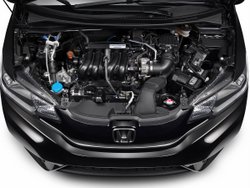
Under harder acceleration the engine’s drone let me know it was working hard and, typical of a CVT, rpms raced quicker than actual speed. Once the speed was reached and I let off the pedal, the revs dropped and the engine quieted down to a normal level. Road and wind noise were noticeable, but no more so than other small hatchbacks.
On smooth road surfaces the Fit offered up a rather delightful ride. But ride quality changes on bumpy or cratered pavement where almost all bumps and ruts in the road are felt, but only the largest are intrusive.
I thought the variable-assist electric steering system was better here than in many other cars and its heft and action felt natural. When called upon, the car maneuvered quickly with control. The brake pedal was reassuringly firm and smooth stops were second nature.
For years I have pined for my Rabbit, but everything I loved about it the Fit trumps by about a hundred times.
Are you listening Larry? I think a red 2016 Honda Fit would look great in the garage.
Larry’s Turn….
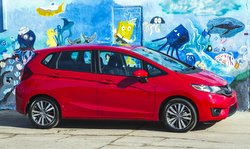
A few Fit rivals offer more than one engine — some are even turbocharged — but the 2016 model again relies on one naturally aspirated four-cylinder of 1.5-liters. This is a new, more modern engine. However, it has a dual—instead of single—overhead camshaft design and the efficiency advantages of direct fuel injection. Horsepower is 130, up from 117 in the previous model. Torque increases to 114 pounds-feet, from 106.
Raw speed was never the Fit’s strong suit, but the latest increases in power and torque elevate acceleration from near the back of the class to the upper middle. A sprint to 60 mph is now a commendable 8.5 seconds.
Fit’s suspension remains subcompact-typical, with a rear torsion beam and drum brakes. That’s prosaic compared with the fully independent suspension and four-wheel-disc brakes of the top cars just one class size up. Same goes for the modestly sized wheels and tires, 15-inch on the base model, 16s on uplevel versions.
But get the little hatchback on a twisty road, and a new body structure and Honda’s astute suspension tuning trumps the humble blueprint. Fit responds alertly to inputs from its sharp steering and bites into corners eagerly, succumbing to noseplow only on high-speed bends that expose the limited grip of the tires.
Compared to others, I think the CVT is best of its ilk. It was surprisingly responsive and shifts were executed immediately after flicking the steering wheel paddle shifters.
I really enjoyed our week with the Fit; Lynne even more so. I classified the outgoing model as a nice city and suburban runabout, now it not only shows off some genuinely athletic moves, but it’s also a conveyance for long drives at highway speeds.
While the base LX with the CVT is EPA rated 41-mpg highway/33-mpg city/36-mpg combined, the additional weight of our top-end EX-L with Navi lowers the numbers to 38 highway/32 city/35 combined. Lynne clocked a majority of the 643 miles we drove, and thanks to her more sensible driving manners, we averaged 41.7 mpg.
The 2016 Honda Fit in the Marketplace
Unlike most subcompact cars, Honda does not offer the Fit in a sedan body style; it’s hatchback only. If you start the buying process by looking at pricing, the 2016 Honda Fit prices will likely be
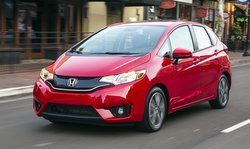
higher relative to the base prices of competitors. That’s because of Honda’s practice against stand-alone options. Instead, the automaker equips each trim level with a fixed set of features that expands as you climb the price ladder. In the end, price differences shrink when competitors are optioned to compete with comparably equipped Fit.
The 2016 Honda Fit is not shy with standard features. Even at the humble price of $15,650 the base LX with manual transmission includes full power accessories, a rearview camera, redundant steering wheel controls, cruise control, as well as Bluetooth and iPod integration.
Our range-topping EX-L with navigation test driver added leather upholstery, heated front seats, heated outside mirrors, a moonroof and satellite and HD radio, which increased the price to $21,590 including destination charges.
The top competitors are the Chevrolet Sonic, Ford Fiesta, Hyundai Accent, Volkswagen Golf, Scion iM and Nissan Versa Note. None of these come close to providing the type of space versatility of the 2016 Honda Fit. Plus, it delivers unexpected performance, a long list of standard and available features and exceptional fuel economy.
Related Stories You Might Enjoy:
Road Test: 2014 Nissan Versa Note
Road Test: 2015 Honda Fit
First Drive: 2015 Kia Soul EV
Road Test: 2015 Volkswagen Golf TDI
Road Test: 2016 Scion iM
Disclosure:
Clean Fleet Report is loaned free test vehicles from automakers to evaluate, typically for a week at a time. Our road tests are based on this one-week drive of a new vehicle, which does not address issues such as long-term reliability or total cost of ownership. In addition we are often invited to manufacturer events highlighting new vehicles or technology, during which we may be offered free transportation, lodging or meals. We do our best to present our unvarnished evaluations of vehicles and news irrespective of these inducements. Our focus is on vehicles that offer the best fuel economy in their class or are among the top mpg vehicles on the market. In addition, we aim to offer reviews and news on advanced technology and the alternative fuel vehicle market. We welcome any feedback from vehicle owners and are dedicated to providing a forum for alternative viewpoints. Please let us know your views at publisher@cleanfleetreport.com.

8 thoughts on “Road Test: 2016 Honda Fit”